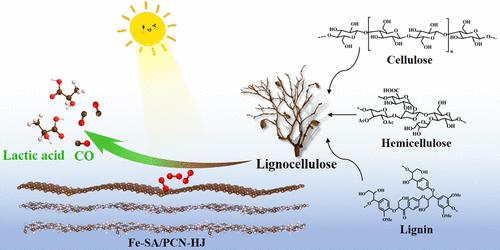Photoreforming of Lignocellulose into CO and Lactic Acid over a Single-Atom Fe-Dispersed Order/Disorder Polymeric Carbon Nitride Homojunction
IF 11.3
1区 化学
Q1 CHEMISTRY, PHYSICAL
引用次数: 0
Abstract
Photoreforming lignocellulose into valuable fuels and chemicals represents an environmentally friendly and energy-saving technology. Herein, a single-atom Fe-dispersed order/disorder polymeric carbon nitride homojunction (Fe-SA/PCN-HJ) is constructed for highly efficient photocatalytic reforming of lignocellulose into CO and lactic acid, wherein Fe single atoms are confined to the surface of the PCN-HJ. Experimental investigations and density functional theory (DFT) calculations reveal that the homojunctions and dispersed Fe atoms on the surface greatly improve the separation efficiency and transport of photogenerated charge carriers. As such, driven by the internal electric field across the entire junction, the photoinduced electrons can rapidly migrate from the bulk to the surface, leading to the enrichment of surface electrons at the dispersed Fe–N4 sites. In addition, the Fe–N4 sites optimize the adsorption and activation of molecular oxygen and facilitate electron transfer to the adsorbed molecular oxygen, thereby promoting the formation of reactive oxygen species for lignocellulose photoreforming. Under full spectrum irradiation for 2 h, the Fe-SA/PCN-HJ exhibits an ultrahigh CO generation rate of 92.33 mmol g–1 and yields 136.21 mg of lactic acid by using 900 mg of fructose as the model substrate. Moreover, we have further demonstrated that the Fe-SA/PCN-HJ photocatalyst presents universally applicable capabilities for the photoreforming of various types of lignocellulosic biomass. This work provides an approach for the production of CO and lactic acid through the photoreforming of lignocellulose, which is promising for the production of fuels and valuable chemicals.

木质纤维素在单原子铁分散的有序/无序聚合物氮化碳均相结上光复生成一氧化碳和乳酸
将木质纤维素光转化为有价值的燃料和化学品是一项环保节能技术。本文构建了一种单原子铁分散有序/无序聚合氮化碳均质结合物(Fe-SA/PCN-HJ),用于将木质纤维素高效光催化转化为一氧化碳和乳酸。实验研究和密度泛函理论(DFT)计算表明,表面上的同质结和分散的铁原子大大提高了光生电荷载流子的分离效率和传输能力。因此,在整个结的内部电场的驱动下,光诱导电子可以迅速从主体迁移到表面,从而导致分散的 Fe-N4 位点的表面电子富集。此外,Fe-N4 位点还能优化分子氧的吸附和活化,促进电子转移到吸附的分子氧上,从而促进木质纤维素光转化过程中活性氧的形成。以 900 毫克果糖为模型底物,在全光谱照射 2 小时后,Fe-SA/PCN-HJ 表现出 92.33 mmol g-1 的超高 CO 生成率,并产生 136.21 毫克乳酸。此外,我们还进一步证明,Fe-SA/PCN-HJ 光催化剂具有普遍适用于各类木质纤维素生物质光转化的能力。这项工作为通过木质纤维素的光转化生产二氧化碳和乳酸提供了一种方法,有望用于生产燃料和有价值的化学品。
本文章由计算机程序翻译,如有差异,请以英文原文为准。
求助全文
约1分钟内获得全文
求助全文
来源期刊

ACS Catalysis
CHEMISTRY, PHYSICAL-
CiteScore
20.80
自引率
6.20%
发文量
1253
审稿时长
1.5 months
期刊介绍:
ACS Catalysis is an esteemed journal that publishes original research in the fields of heterogeneous catalysis, molecular catalysis, and biocatalysis. It offers broad coverage across diverse areas such as life sciences, organometallics and synthesis, photochemistry and electrochemistry, drug discovery and synthesis, materials science, environmental protection, polymer discovery and synthesis, and energy and fuels.
The scope of the journal is to showcase innovative work in various aspects of catalysis. This includes new reactions and novel synthetic approaches utilizing known catalysts, the discovery or modification of new catalysts, elucidation of catalytic mechanisms through cutting-edge investigations, practical enhancements of existing processes, as well as conceptual advances in the field. Contributions to ACS Catalysis can encompass both experimental and theoretical research focused on catalytic molecules, macromolecules, and materials that exhibit catalytic turnover.
 求助内容:
求助内容: 应助结果提醒方式:
应助结果提醒方式:


